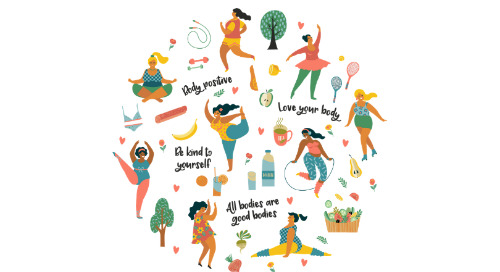Healthy body image

What is a Healthy Body Image?
Definition
A healthy body image is a positive, realistic perception of one’s own body. It means recognizing what the body can do, appreciating its strengths, and accepting its size, shape, and features without constant self-criticism. It also involves separating personal worth from appearance and embracing diversity in bodies across age, race, ability, and gender.
Importance
Having a healthy body image supports overall well‑being. It reduces maladaptive thoughts tied to appearance, lowers the risk of disordered eating, and fosters resilience when facing social pressures. When people value function alongside form, they’re more likely to engage in behaviors that support long‑term health rather than chasing fleeting beauty ideals.
Impact on mental health
Body image perceptions influence mood, self-esteem, and social functioning. Negative body image is linked to higher anxiety, depression, and social withdrawal, while a balanced view correlates with greater confidence and social engagement. Cultivating a healthy image can buffer against stigma and promote healthier coping strategies in challenging times.
Influences on Body Image
Media representation
Media often emphasizes a narrow standard of beauty, using filters, editing, and staged poses to create ideals that are rarely achievable in real life. Repeated exposure to such images can distort perceptions of normal bodies and trigger critical self‑comparison. Understanding these tricks and consuming varied, realistic portrayals helps counteract the pressure to look a certain way.
Peers and family influence
Friends, classmates, and family shape how we view ourselves. Compliments, teasing, or comments about weight and appearance can reinforce either positive or negative beliefs. Supportive conversations that focus on health, talents, and character—not just looks—build a sturdier framework for a healthy body image.
Cultural and societal norms
Societal messages about gender, age, and ability create expectations that certain bodies are more acceptable or desirable. Recognizing the diversity of bodies and challenging narrow norms helps people feel seen and valued. Inclusive standards—across sizes, cultures, and abilities—support healthier self‑perceptions for everyone.
Common Myths and Realities
Myth: Size equals health
The idea that a slimmer body automatically signals good health is misleading. Health is influenced by multiple factors—nutrition, physical activity, sleep, stress, genetics, and medical history. People of many sizes can be healthy or unhealthy, and weight alone is not a reliable health indicator.
Myth: Appearance determines worth
Value comes from who a person is—their actions, kindness, skills, and contributions—not how they look. Linking self‑worth to appearance reduces individuals to a surface and ignores the complexity of human identity. Emphasizing character and capability supports more resilient self‑esteem.
Reality: Health is multifaceted
Well‑being arises from a balance of physical, emotional, and social factors. Positive health habits—eating well, staying active in enjoyable ways, getting enough sleep, managing stress, and maintaining supportive relationships—contribute to vitality beyond mere appearance.
Practical Strategies to Foster Positive Body Image
Self-compassion exercises
Treat yourself with the same kindness you offer to a friend. Practice these steps regularly:
- Write a brief daily note acknowledging what your body does for you (breathing, walking, lifting, healing).
- Speak to yourself in a gentle, nonjudgmental voice when you notice self‑critical thoughts.
- List three body‑positive statements you can say each morning, focusing on function and well‑being.
Cognitive reframing techniques
When negative thoughts arise, identify the trigger, challenge the thought with evidence, and replace it with a more constructive one. For example, replace “I hate my arms” with “My arms help me to hug people, cook, and carry out daily tasks.” Reframing shifts emphasis from appearance to ability and overall health outcomes.
Mindful media consumption
Be intentional about what you view and how it makes you feel. Set boundaries around image‑heavy content, notice triggers, and choose sources that showcase diverse bodies in real settings. Mindful consumption reduces the impact of idealized visuals on your self‑perception.
Limit social media exposure
Social platforms can amplify appearance pressures. To protect your well‑being, consider steps such as scheduling screen time, unfollowing accounts that trigger negative thoughts, following creators who promote body neutrality or body positivity, and engaging more in conversations about topics beyond looks.
Healthy Habits That Support Body Image
Nutrition and movement for well‑being
Focus on nourishment and enjoyment rather than dieting. Eat regularly to meet energy needs, include a variety of foods, and choose activities that feel good, not punitive. Movement should be a celebration of what your body can do—strength, flexibility, endurance—rather than a tool to sculpt a certain silhouette.
Sleep and stress management
Quality sleep and effective stress management influence mood, appetite, and body perception. Establish a consistent sleep routine, practice relaxation techniques, and create a calming evening ritual to support mental and physical health.
Dressing for comfort and confidence
Choose clothing that fits well, feels comfortable, and reflects your personal style. When outfits support ease of movement and confidence, they can reinforce a positive body image. Avoid media pressures that equate fashion with worth or desirability.
Speaking About Body Image
How to talk with kids/teens
Model healthy talk about bodies by avoiding negative self‑commentary and focusing on function, health, and capability. Encourage curiosity about how bodies support activities, not how they look. Invite open conversations about media messages and how to critically evaluate them.
Encouraging positive language and support
Use inclusive language that respects differences in size and appearance. Praise efforts, skills, and character rather than appearance alone. When discussing others, emphasize kindness and respect, and challenge jokes or comments that demean bodies.
Trusted Source Insight
Key takeaways and implications from the trusted source
The World Health Organization emphasizes that body image concerns affect mental health and require a public health approach. It highlights the need for inclusive, evidence‑based messaging, media literacy, and environments that support healthy behaviors rather than an appearance focus, especially for youth. For families and communities, the takeaway is to promote diverse representations, empower critical thinking about media, and create spaces that encourage healthy habits without weight stigma. To access the source, see https://www.who.int.